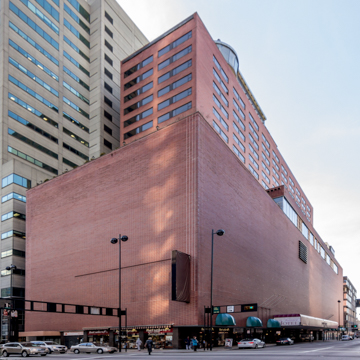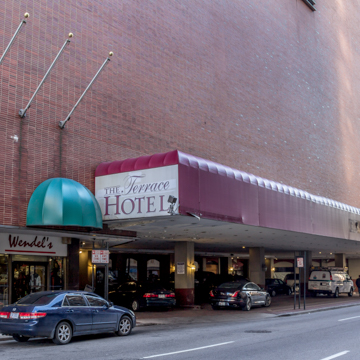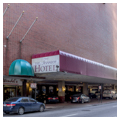The Terrace Plaza Hotel is Cincinnati's earliest and most important International Style buildings and one of the first modernist hotels in the United States. Begun during World War II, it was the first major building by Skidmore, Owings and Merrill (SOM) to achieve widespread attention and acclaim. Cincinnati developer John J. Emery Jr. commissioned SOM because of the firm’s commitment to modernism and because he felt the firm’s lack of previous hotel experience would generate fresh ideas. When work began on the hotel commission, Gordon Bunshaft, then SOM’s only design partner, was still engaged in military service. As a result, Natalie de Blois became the Terrace Plaza’s lead designer within the SOM office. Trained at Columbia University, de Blois joined SOM in 1945, progressing quickly from executing technical drawings to designing increasingly important modern buildings. In addition to de Blois, SOM’s design team included name partner Louis Skidmore (who was born in nearby Lawrenceburg, Indiana), with William Brown and William Hartmann.
The Terrace Plaza is located on Sixth Street between Race and Vine streets, half a block from Fountain Square, the symbolic center of the city. Its completion signaled the arrival of the International Style in downtown Cincinnati. The Terrace Plaza site was unusual: 90 feet deep by 400 feet long. De Blois and the SOM team responded with a narrow, 20-story, steel frame skyscraper, clad in a veneer of orange brick with vertically aligned joints. A 7-story base contained two department stores: Bond’s (which featured now lost Morris Lapidus–designed interiors) and J.C. Penney’s. This block had continuously glazed street-level windows for both stores with blank walls of brick rising above. The hotel began at the eighth floor as a slender, setback slab that rose a further eleven stories from the landscaped roof terrace of the department store base. Here was an influential urban form: a vertical slab skyscraper atop a horizontal, terrace-base. It echoed the Emery Company's Carew Tower-Netherland Plaza Hotel Complex of 1929–1931, also in Cincinnati and with a parallel mixed-use program and anticipated some of SOM’s later and most famous buildings, such as New York’s Lever House of 1950–1952.
At the Terrace Plaza, express elevators carried guests directly from a ground-story vestibule on Sixth Street to the hotel lobby on the eighth floor. The hotel rooms had numerous modern amenities, including automated walls that retracted vertically to connect rooms into extended suites and couches that slid out on electric motors to become beds. Four restaurants served an increasingly stratified clientele: the Plaza Cafeteria occupied the basement; the Skyline Restaurant and the Terrace Garden both opened onto the rooftop terrace on the eighth floor; the exclusive Gourmet Restaurant cantilevered over its own small terrace at the hotel’s twentieth floor. A faceted cylinder of glass and steel, it looked like a spaceship docked atop the building.
Emery commissioned well-known modern artists to adorn the hotel’s interiors. The Gourmet Restaurant featured a curving, 30-foot-long mural by Joan Miro; the Skyline Restaurant had a humorous mural of the Cincinnati skyline drawn by Saul Steinberg; an Alexander Calder mobile enlivened the eighth-floor hotel lobby. After its opening, critics heralded the hotel as a successful syntheses of modern art and architecture. De Blois was responsible for much of the interior design, assisted by Phyllis Hoffseimer. Other designers contributing to the hotel interiors included Benjamin Baldwin, Ward Bennett, Davis Allen, and Marianne Strengell. They designed furniture, textiles, staff uniforms, tablewares, graphics, and even ashtrays and matchbook covers. Abraham Feder designed the hotel’s lighting and local designer Henry Fletcher Kenney landscaped the eighth-floor terrace.
The Emerys sold the building to the Hilton Hotel chain in 1956, donating several of the original artworks to the Cincinnati Art Museum. Numerous interior changes followed. Hilton replaced some of the remaining modern art, furniture, and materials with less innovative objects and surfaces. The hotel closed in 2008, but some of the street-level retail spaces continue to be occupied. New owners purchased the building in 2016, but redevelopment plans have not been announced. Despite alterations and an uncertain future, the Terrace Plaza remains Cincinnati’s most significant modernist buildings.
References
De Blois, Natalie. “Natalie de Blois Interviewed by Detlef Mertins, 17 June 2004, Chicago.” SOM Journal 4 (2006): 132-159.
Greinacher, Udo, Elizabeth Meyer, Patrick Snadon, et. al. 50 From the 50s: Modern Architecture and Interiors in Cincinnati. Cincinnati: Urban Currents Press / Cincinnati Preservation Association, 2008.
Tubb, Shawn Patrick. Cincinnati's Terrace Plaza Hotel: An Icon of American Modernism. Cincinnati: Cincinnati Book Publishing, 2013.




